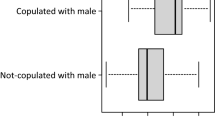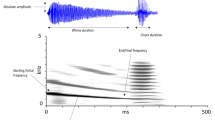Abstract
After pair formation, male crickets should reduce calling to minimize the risks to males of attracting predators and/or rivals. We tested this hypothesis in two cricket species, one in which males exhibit a high mating propensity (Gryllus veletis)and another in which the mating propensity of males is constrained by the manufacture of elaborate, bipartite spermatophores (Gryllodes sigillatus).Calling durations of male G. veletisdeclined precipitously after the introduction of females but remained unchanged in G. sigillatus.We attribute the asymmetric effect of female proximity on male calling to differences in the mating propensity of males of the two species. Male G. veletisabstain from further calling in favor of repeated matings with the same female. Male G. sigillatusprobably lack the opportunity to mate repeatedly with the same female and, thus, resume calling shortly after mating to increase their probability of attracting additional mates.
Similar content being viewed by others
References
Alexander, R. D. (1962). Evolutionary change in cricket acoustical communication.Evolution 16: 443–467.
Alexander, R. D. (1967). Acoustical communication in arthropods.Annu. Rev. Entomol. 12: 495–526.
Alexander, R. D., and Meral, G. H. (1967). Seasonal and daily chirping cycles in the northern spring and fall field crickets,Gryllus veletis and Gpennsylvanicus.Ohio J. Sci. 67: 200–209.
Backus, V. L., and Cade, W. H. (1986). Sperm competition in the field cricketGryllus integer (Orthoptera: Gryllidae).Fla. Entomol. 69: 722–728.
Bell, P. D. (1979). Acoustic attraction of herons by crickets.J. N.Y. Entomol. Soc. 87: 126–127.
Belwood, J. J., and Morris, G. K. (1987). Bat predation and its influence on calling behavior in neotropical katydids.Science 238: 64–67.
Boake, C. R. B. (1983). Mating systems and signals in crickets. In Gwynne, D. T., and Morris, G. K. (eds.),Orthopteran Mating Systems: Sexual Competition in a Diverse Group of Insects, Westview Press, Boulder, CO, pp. 28–44.
Burk, T. (1988). Acoustic signals, arms races and the costs of honest signalling.Fla. Entomol. 71: 400–409.
Burpee, D. M., and Sakaluk, S. K. (1993). Repeated matings offset costs of reproduction in female crickets.Evol. Ecol. 7: in press.
Cade, W. (1975). Acoustically orienting parasitoids: Fly phonotaxis to cricket song.Science 190: 1312–1313.
Cade, W. (1979). The evolution of alternative male reproductive strategies in field crickets. In Blum, M. S., and Blum, N. A. (eds.),Sexual Selection and Reproductive Competition in Insects, Academic Press, New York, pp. 343–379.
Cade, W. (1980). Alternative male reproductive behaviors.Fla. Entomol. 63: 30–45.
Cade, W. H. (1985). Insect mating and courtship behaviour. In Kerkut, G. A., and Gilbert, L. I. (eds.),Comprehensive Insect Physiology, Biochemistry and Pharmacology, Pergamon Press, Oxford, pp. 591–619.
Cade, W. H., and Wyatt, D. R. (1984). Factors affecting calling behaviour in field crickets,Teleogryllus andGryllus (Age, weight, density, and parasites).Behaviour 88: 61–75.
French, B. W., and Cade, W. H. (1987). The timing of calling, movement, and mating in the field cricketsGryllus veletis, G. pennsylvanicus, and G.integer.Behav. Ecol. Sociobiol. 21: 157–162.
Heath, J. E., and Josephson, R. K. (1970). Body temperature and singing in the katydid,Neoconocephalus robustus (Orthoptera, Tettigoniidae).Biol. Bull. 138: 272–285.
Hedrick, A. V. (1986). Female preferences for male calling bout duration in a field cricket.Behav. Ecol. Sociobiol. 19: 73–77.
Hissmann, K. (1990). Strategies of mate finding in the European field cricket (Gryllus campestris) at different population densities: A field study.Ecol. Entomol. 15: 281–291.
Huber, F. (1962). Central nervous control of sound production in crickets and some speculation on its evolution.Evolution 16: 429–442.
Kavanagh, M. W. (1987). The efficiency of sound production in two cricket species,Gryllotalpa australis andTeleogryllus commodus (Orthoptera: Grylloidea).J. Exp. Biol. 130: 107–119.
Kidder, G. W., III, and Sakaluk, S. K. (1989). Simple and inexpensive electronic device for automatic recording and analysis of insect acoustical activity.Fla. Entomol. 72: 642–649.
Loher, W. (1974). Circadian control of spermatophore formation in the cricketTeleogryllus commodus Walker.J. Insect Physiol. 20: 1155–1172.
Loher, W., and Rence, B. (1978). The mating behavior ofTeleogryllus commodus (Walker) and its central and peripheral control.Z. Tierpsychol. 46: 225–259.
Otte, D. (1977). Communication in Orthoptera. In Sebeok, T. A. (ed.),How Animals Communicate, Indiana University Press, Bloomington, pp. 334–361.
Otte, D., and Alexander, R. D. (1983).The Australian Crickets (Orthoptera: Gryllidae), Monograph 22, Academy of Natural Sciences of Philadelphia.
Parker, G. A., Simmons, L. W., and Kirk, H. (1990). Analysing sperm competition data: Simple models for predicting mechanisms.Behav. Ecol. Sociobiol. 27: 55–65.
Popov, A. V., and Shuvalov, V. F. (1977). Phonotactic behavior of crickets.J. Comp. Physiol. A 119: 111–126.
Prestwich, K. N., and Walker, T. J. (1981). Energetics of singing in crickets: Effect of temperature in three trilling species (Orthoptera: Gryllidae).J. Comp. Physiol. B 143: 199–212.
Rost, R., and Honegger, H. W. (1987). The timing of premating and mating behavior in a field population of the cricketGryllus campestris L.Behav. Ecol. Sociobiol. 21: 279–289.
Sakaluk, S. K. (1984). Male crickets feed females to ensure complete sperm transfer.Science 223: 609–610.
Sakaluk, S. K. (1985). Spermatophore size and its role in the reproductive behaviour of the cricket,Gryllodes supplicans (Orthoptera: Gryllidae).Can. J. Zool. 63: 1652–1656.
Sakaluk, S. K. (1986). Sperm competition and the evolution of nuptial feeding behavior in the cricket,Gryllodes supplicans (Walker).Evolution 40: 584–593.
Sakaluk, S. K. (1987). Reproductive behaviour of the decorated cricket,Gryllodes supplicans (Orthoptera: Gryllidae): Calling schedules, spatial distribution, and mating.Behaviour 100: 202–225.
Sakaluk, S. K. (1990). Sexual selection and predation: Balancing reproductive and survival needs. In Evans, D. L., and Schmidt, J. O. (eds.),Insect Defenses: Adaptive Mechanisms and Strategies of Prey and Predators, State University of New York Press, Albany, pp. 63–90.
Sakaluk, S. K. (1991). Post-copulatory mate guarding in decorated crickets.Anim. Behav. 41: 207–216.
Sakaluk, S. K., and Belwood, J. J. (1984). Gecko phonotaxis to cricket calling song: A case of satellite predation.Anim. Behav. 32: 659–662.
Sakaluk, S. K., and Cade, W. H. (1980). Female mating frequency and progeny production in singly and doubly mated house and field crickets.Can. J. Zool. 58: 404–411.
Sakaluk, S. K., and Cade, W. H. (1983). The adaptive significance of female multiple matings in house and field crickets. In Gwynne, D. T., and Morris, G. K. (eds.),Orthopteran Mating Systems: Sexual Competition in a Diverse Group of Insects, Westview Press, Boulder, CO, pp. 319–336.
Sakaluk, S. K., and Snedden, W. A. (1990). Nightly calling durations of male sagebrush crickets,Cyphoderris strepitans: Size, mating and seasonal effects.Oikos 57: 153–160.
SAS Institute Inc. (1988).SAS/STAT User's Guide, Release 6.03 Edition, SAS Institute, Cary, NC.
Simmons, L. W. (1987). Sperm competition as a mechanism of female choice in the field cricket,Gryllus bimaculatus.Behav. Ecol. Sociobiol. 21: 197–202.
Snedden, W. A., and Sakaluk, S. K. (1992). Acoustical signalling and its relation to male mating success in sagebrush crickets.Anim. Behav. 44: 633–639.
Walker, T. J., Jr. (1957). Specificity in the response of female tree crickets (Orthoptera, Gryllidae, Oecanthinae) to calling songs of the males.Ann. Entomol. Soc. Am. 50: 626–636.
Walker, T. J. (1964). Experimental demonstration of a cat locating orthopteran prey by the prey's calling song.Fla. Entomol. 47: 163–165.
Walker, T. J. (1983a). Diel patterns of calling in nocturnal Orthoptera. In Gwynne, D. T., and Morris, G. K. (eds.),Orthopteran Mating Systems: Sexual Competition in a Diverse Group of Insects, Westview Press, Boulder, CO, pp. 45–72.
Walker, T. J. (1983b). Mating modes and female choice in short-tailed crickets(Anurogryllus arboreus). In Gwynne, D. T., and Morris, G. K. (eds.),Orthopteran Mating Systems: Sexual Competition in a Diverse Group of Insects, Westview Press, Boulder, CO, pp. 240–267.
Walker, T. J. (1989). A live trap for monitoringEuphasiopteryx and tests withE. ochracea (Diptera: Tachinidae).Fla. Entomol. 72: 314–319.
Zuk, M. (1987). The effects of gregarine parasites, body size, and time of day on spermatophore production and sexual selection in field crickets.Behav. Ecol. Sociobiol. 21: 65–72.
Author information
Authors and Affiliations
Rights and permissions
About this article
Cite this article
Burpee, D.M., Sakaluk, S.K. the effect of pair formation on diel calling patterns in two cricket species,Gryllus veletis andGryllodes sigillatus (Orthoptera: Gryllidae). J Insect Behav 6, 431–440 (1993). https://doi.org/10.1007/BF01049523
Accepted:
Issue Date:
DOI: https://doi.org/10.1007/BF01049523




